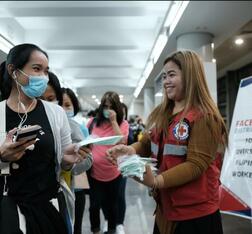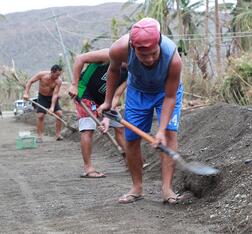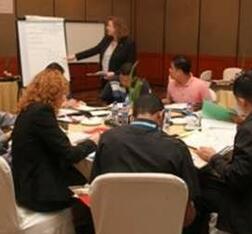
What are the main achievements you see in the new legislation?
The current law is more reactionary in nature rather than proactive. Now, with the new bill, the emphasis is more on response. Until now, calamity funds could only be used after a disaster, as a result, preparedness activities are not fully in place in the community level. The new bill has a holistic approach to risk reduction, from prevention, mitigation to response.
How will the new bill change the way things are done in the Philippines?
The Philippines National Red Cross (PNRC) has always been involved in areas of preparedness, prevention and recovery. In 1994, PNRC started disaster risk reduction activities through its integrated community disaster preparedness programmes. Between that time and the passing of the bill, the main challenge for us was that there was no specific local government fund that we could draw upon to ensure sustainability of our earlier initiatives. The disaster management law at that time provided calamity funds that could only be accessed when a state of calamity was declared. Thus, preparedness had to come after disasters happen. Now we, and all other actors, will have an enabling working environment for promoting risk reduction initiatives without necessarily waiting for the declaration of a state of calamity.
The new bill also creates focus areas, namely preparedness, prevention and recovery, each with a vice chair who will be the main focal point for each sector.
In addition, the bill ensures the integration of Disaster Risk Reduction into the school curriculum thus providing an enabling environment for DRR practitioners like us to ensure complete buy in and participation of the schools without disrupting any of their activities. It also makes that subject mandatory. We are happy that this is now included in the law.
This new bill also incorporates climate change and establishes a comprehensive early warning system. These are very interesting tools for the PNRC which, as a member of the IFRC, promotes climate change adaptation and works on early warning systems. The bill could also introduce stronger advocacy from grass roots and civil societies as it provides 4 seats for NGOs in the National Disaster Risk Management Council. Therefore, Partnership with NGOs can be further strengthened and fostered considerably.
How has the funding mechanism changed?
In Philippines, each local government should allocate 5% of their state income to the National Calamity Fund. According to the old law, the fund could only be used post-disaster. The new bill, on the other hand, allows the utilisation of the fund even without the declaration of a state of calamity for preparedness activities. It also makes possible the use of the National Calamity Fund without the declaration of the state of emergency and to also focus on preparedness and mitigation work.
What was the process involved in the development of the bill?
The Government initiated a multi stakeholder dialogue for the Philippines Strategic National Action Plan, with regards to the Government’s commitment to the Hyogo Framework for Action. Given that disaster risk reduction is the topmost issue, all stakeholders feel that there is a need to have an enabling law that will support the realisation of the Hyogo commitments. Technical Working Groups (TWG) were created. One of these groups’ missions was to review the current disaster management law. This group is made up of representatives from all segments involved in disaster management in the country, including the PNRC.
The TWGs and other disaster risk reduction practitioners played a great role in advocating for the passage of a bill that truly puts emphasis on risk reduction. The typhoons in September 2009 also influenced the integration of the bill in the House and the Senate.
How was PNRC involved in the advocacy process?
PNRC had the advantage of having Chairman Richard Gordon and Juan Miguel Zubiri, both members of the Board of Governors of the PNRC and senators, as the proponents of the bill in the Senate. Also, as a member of the TWG, we lobbied in the Senate and the Congress alike.
Were there any challenges and/or obstacles to making the changes?
The primary challenge was how to merge or integrate the differing versions of the law that were introduced in the Congress and the Senate. But strong advocacy of DM stakeholders paid off. Also, a potential challenge lies in the implementation of the law once signed by the President, especially since it will involve the changing of mindsets at the local level, particularly the chief executives of the towns, cities and provinces. Massive information and education campaign and strong advocacy needs are needed to overcome this challenge.
Could you tell us about the brief section of the new bill related to international relief?
This is a good progress as previous law did not clearly spell out measures on international assistance. We already have the International Humanitarian Network (IHAN), which was created as a result of ASEAN’s Agreement on Disaster Management and Emergency Response (AADMER). At this stage, IHAN is the reference point for National Disaster Coordinating Council (NDCC) regarding international relief. In my opinion, this document is sufficient in form and substance at the moment. I am sure there will be annexes and new guidelines developed to support this Bill in the future.
What are the next steps in the implementation of the bill?
The bill will be enacted as soon as the President signs it. Then, the next step is to implement in all levels of administration, from the national to the local level, through the local government units and to ensure that the major points of the bill are implemented and carried out by the chief executives. There has to also be a change on how local chief executives of the community see and implement the law. This will include a lot of education and information, with the Department of Interior and Local Government leading the work and with lead agencies focusing on each sector.
From the PNRC’s point of view, the new approach guarantees the sustainability of our community-based disaster risk reduction programs. It will also give us an enabling environment to ensure allocation of local budget in our community programs on Disaster management.


